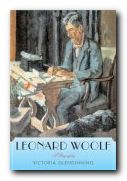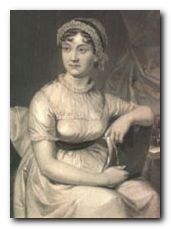 David Cecil, A Portrait of Jane Austen, London: Constable, 1978.
David Cecil, A Portrait of Jane Austen, London: Constable, 1978.
R.W. Chapman (ed) Jane Austen’s Letters to her Sister Cassandra and Others, (2nd edn) London 1952, repr. 1979.
R.W. Chapman, Jane Austen: Facts and Problems, Oxford 1948, repr. 1970.
Edward Copeland (ed), The Cambridge Companion to Jane Austen, Cambridge University Press, 1997.
John Halperin, The Life of Jane Austen, Baltimore and London, 1984.
Claire Harman, Jane’s Fame: How Jane Austen Conquered the World, Cannongate Books, 2010.
Park Honan, Jane Austen: her life, London: Weidenfeld and Nicolson, 1987.
Elizabeth Jenkins, Jane Austen: a Biography, London: Gollancz, 1949.
Marghanita Laski, Jane Austen, London: Thames and Hudson, 1975.
Deirdre le Fay, Jane Austen’s Letters, Oxford University Press, 1997.
Valerie Grosvenor Myer, Obstinate Heart: Jane Austen – A Biography, Michael O’Mara Books, 1997.
Catherine Reef, Jane Austen: A Life Revealed, Houghton Mifflin, 2011.
Jon Spence, Becoming Jane Austen, Hambledon Continuum, 2007.
George Holbert Tucker, A Goodly Heritage: A History of Jane Austen’s Family, Manchester, 1983.
Claire Tomalin, Jane Austen: A Life, Penguin, 2003.
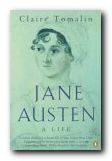 Jane Austen: a Life is a biography which traces Jane Austen’s progress through a difficult childhood, an unhappy love affair, her experiences as a poor relation and her decision to reject a marriage that would solve all her problems – except that of continuing as a writer. Both the woman and the novels are radically reassessed in this biography. Her life was superficially uneventful, but Claire Tomalin brings out the flesh and blood woman who lies behind the cool, ironic prose.
Jane Austen: a Life is a biography which traces Jane Austen’s progress through a difficult childhood, an unhappy love affair, her experiences as a poor relation and her decision to reject a marriage that would solve all her problems – except that of continuing as a writer. Both the woman and the novels are radically reassessed in this biography. Her life was superficially uneventful, but Claire Tomalin brings out the flesh and blood woman who lies behind the cool, ironic prose.
 The Complete Critical Guide to Jane Austen is a good introduction to Austen criticism and commentary. It includes a potted biography, an outline of the novels, and pointers towards the main critical writings – from Walter Scott to critics of the present day. It also includes a thorough bibliography which covers biography, criticism in books and articles, plus pointers towards specialist journals. It also has an interesting chapter discussing Austen on the screen. These guides are very popular.
The Complete Critical Guide to Jane Austen is a good introduction to Austen criticism and commentary. It includes a potted biography, an outline of the novels, and pointers towards the main critical writings – from Walter Scott to critics of the present day. It also includes a thorough bibliography which covers biography, criticism in books and articles, plus pointers towards specialist journals. It also has an interesting chapter discussing Austen on the screen. These guides are very popular.
© Roy Johnson 2009
Jane Austen web links
Jane Austen greatest works
Jane Austen biographical studies
Jane Austen life and works
Jane Austen literary criticism
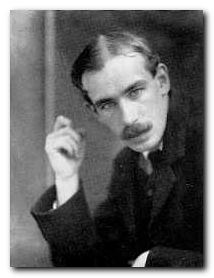 Maynard Keynes was born and raised in Cambridge, the seat of intellectual and political power, even more so then than now. He was also educated at Eaton – and yet his social origins were quite modest. One grandfather John Brown was an apprentice printer from Lancashire who later graduated from Owens College (Manchester University) and went on to become a preacher. The other grandfather made his fortune from cultivating dahlias and roses. His father John Neville Keynes went to University College London and then to Cambridge where he briefly became a lecturer and where he met Keynes’ mother, who was a student at Newnham Hall. However, Neville (the family used their middle names) did not feel suited to the life of a don, and became instead an administrator in the examinations board.
Maynard Keynes was born and raised in Cambridge, the seat of intellectual and political power, even more so then than now. He was also educated at Eaton – and yet his social origins were quite modest. One grandfather John Brown was an apprentice printer from Lancashire who later graduated from Owens College (Manchester University) and went on to become a preacher. The other grandfather made his fortune from cultivating dahlias and roses. His father John Neville Keynes went to University College London and then to Cambridge where he briefly became a lecturer and where he met Keynes’ mother, who was a student at Newnham Hall. However, Neville (the family used their middle names) did not feel suited to the life of a don, and became instead an administrator in the examinations board. At this point Keynes’s personal life became quite complex, with cross-connections that have since made the Bloomsbury Group famous. He was a friend and ex-lover of Lytton Strachey, who had fallen in love with his own cousin
At this point Keynes’s personal life became quite complex, with cross-connections that have since made the Bloomsbury Group famous. He was a friend and ex-lover of Lytton Strachey, who had fallen in love with his own cousin 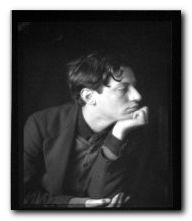 However, this mixing with Bloomsbury also brought him personal distress. Duncan Grant started an affair with
However, this mixing with Bloomsbury also brought him personal distress. Duncan Grant started an affair with  In the early 1920s Keynes was actively involved in solving the lingering problem of post-war reparations, something in which he participated as an economist, a government advisor, and (secretly) as an unofficial diplomatist. At the same time he formed a group to take over the liberal journal Nation and Athenaeum of which he made Leonard Woolf the editor. Then, in the midst of all this, he surprised everyone by falling in love with the Russian ballerina Lydia Lopokova, who stayed in England when Diaghilev de-camped to Monte Carlo.
In the early 1920s Keynes was actively involved in solving the lingering problem of post-war reparations, something in which he participated as an economist, a government advisor, and (secretly) as an unofficial diplomatist. At the same time he formed a group to take over the liberal journal Nation and Athenaeum of which he made Leonard Woolf the editor. Then, in the midst of all this, he surprised everyone by falling in love with the Russian ballerina Lydia Lopokova, who stayed in England when Diaghilev de-camped to Monte Carlo.


 1857. Joseph Conrad (full original name Jozef Teodor Konrad Korzeniowski) born December 3 in Berdichev (or vicinity) to Apollo Nalecz Korzeniowski and Evelina (Ewa) Bobrowska. Poland at that time is under the control of Russia.
1857. Joseph Conrad (full original name Jozef Teodor Konrad Korzeniowski) born December 3 in Berdichev (or vicinity) to Apollo Nalecz Korzeniowski and Evelina (Ewa) Bobrowska. Poland at that time is under the control of Russia.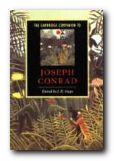 The Cambridge Companion to Joseph Conrad offers a series of essays by leading Conrad scholars aimed at both students and the general reader. There’s a chronology and overview of Conrad’s life, then chapters that explore significant issues in his major writings, and deal in depth with individual works. These are followed by discussions of the special nature of Conrad’s narrative techniques, his complex relationships with late-Victorian imperialism and with literary Modernism, and his influence on other writers and artists. Each essay provides guidance to further reading, and a concluding chapter surveys the body of Conrad criticism.
The Cambridge Companion to Joseph Conrad offers a series of essays by leading Conrad scholars aimed at both students and the general reader. There’s a chronology and overview of Conrad’s life, then chapters that explore significant issues in his major writings, and deal in depth with individual works. These are followed by discussions of the special nature of Conrad’s narrative techniques, his complex relationships with late-Victorian imperialism and with literary Modernism, and his influence on other writers and artists. Each essay provides guidance to further reading, and a concluding chapter surveys the body of Conrad criticism.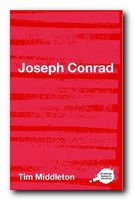 The Complete Critical Guide to Joseph Conrad is a good introduction to Conrad criticism. It includes a potted biography, an outline of the stories and novels, and pointers towards the main critical writings – from the early comments by his contemporaries to critics of the present day. Also includes a thorough bibliography which covers biography, criticism in books and articles, plus pointers towards specialist Conrad journals. These guides are very popular. Recommended.
The Complete Critical Guide to Joseph Conrad is a good introduction to Conrad criticism. It includes a potted biography, an outline of the stories and novels, and pointers towards the main critical writings – from the early comments by his contemporaries to critics of the present day. Also includes a thorough bibliography which covers biography, criticism in books and articles, plus pointers towards specialist Conrad journals. These guides are very popular. Recommended.
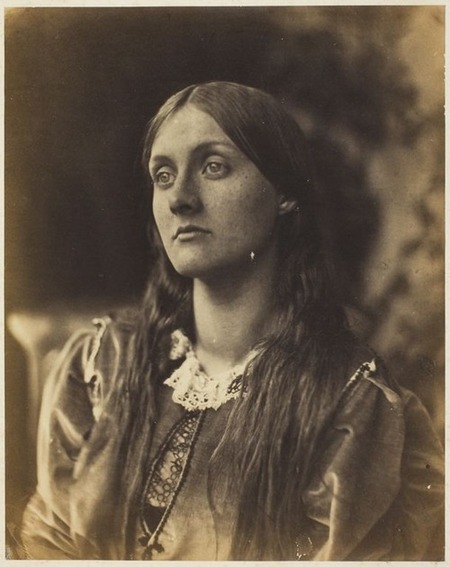
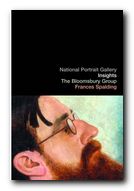 The Bloomsbury Group is a short but charming book, published by the National Portrait Gallery. It explores the impact of Bloomsbury personalities on each other, plus how they shaped the development of British modernism in the early part of the twentieth century. But most of all it’s a delightful collection of portrait paintings and photographs, with biographical notes. It has an introductory essay which outlines the development of Bloomsbury, followed by a series of portraits and the biographical sketches of the major figures who had such a profound influence on the world of literature and the arts between 1900 and 1940.
The Bloomsbury Group is a short but charming book, published by the National Portrait Gallery. It explores the impact of Bloomsbury personalities on each other, plus how they shaped the development of British modernism in the early part of the twentieth century. But most of all it’s a delightful collection of portrait paintings and photographs, with biographical notes. It has an introductory essay which outlines the development of Bloomsbury, followed by a series of portraits and the biographical sketches of the major figures who had such a profound influence on the world of literature and the arts between 1900 and 1940.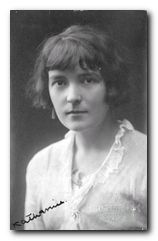 1888. Katherine Mansfield Beauchamp was born into a socially prominent family in Wellington, New Zealand. Her father was a banker, who went on to become chairman of the Bank of New Zealand. She was first cousin of Elizabeth Beauchamp, who married into German aristocracy to become Countess Elizabeth von Arnim. She had a somewhat insecure childhood. Her mother left her when she was only one year old to go on a trip to England. She was raised largely by her grandmother, who features in some of the stories as ‘Mrs Fairfield’.
1888. Katherine Mansfield Beauchamp was born into a socially prominent family in Wellington, New Zealand. Her father was a banker, who went on to become chairman of the Bank of New Zealand. She was first cousin of Elizabeth Beauchamp, who married into German aristocracy to become Countess Elizabeth von Arnim. She had a somewhat insecure childhood. Her mother left her when she was only one year old to go on a trip to England. She was raised largely by her grandmother, who features in some of the stories as ‘Mrs Fairfield’.
